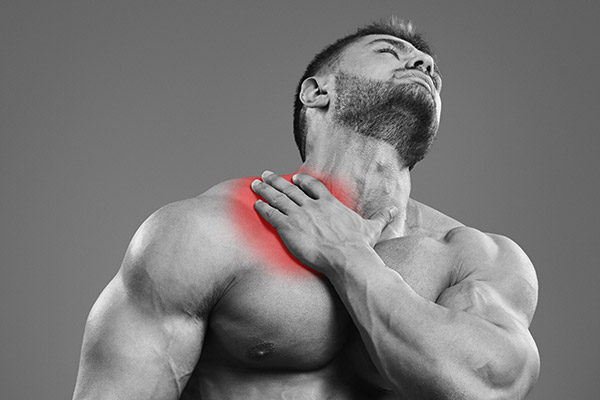Almost everything you thought you knew about healing your workout injuries could need a brain dump. Here’s your revised guide from Dr. Anthony J. Lombardi to curing your hurts so you can recover from injury faster and get busy being strong.
Workout injuries and conventional wisdom
During the past 13 years in private practice, I’ve played my part in more than 100,000 patient visits. All too often the conventional injury wisdom is not always the most effective approach. Leading the charge in injury treatments is the notion that you need to use the RICE – rest, ice, compression and elevation – method to manage every injury.
What’s emerging is a new acronym, which happens to be the antithesis of RICE, and it’s called MEAT, which stands for movement, exercise, analgesics, treatment. To give you an idea of how it works, take the example of the most common injury on the planet: lower back strain.
Whether you lift something the wrong way, injure yourself playing a sport or hurt your back putting on your socks – the best way to manage it so you can recover from injury faster is by using a combination of RICE and MEAT. Using compression and movement right after this kind of injury will support your lower back muscles, which stabilize the spine while flushing away neurogenic inflammation.
This kind of inflammation is caused by a chemical which gets released from the nerves associated with the injured tissue following trauma or prolonged inactivity. This is why rest would be ill advised because it would increase the neurogenic inflammation and cause muscle stiffness, ultimately creating pain and muscle spasms.
The following will teach you how to adapt your approach to workout injuries so you never miss a gym session and always stay strong.

1. Take care of small workout injuries before they become bigger hurts
Following on from the previous example, if you injure your lower back you should immediately wear a lumbar belt support and keep walking and moving around until you can see a health care professional.
This is important because neurogenic inflammation has a lot in common with the notion that one bad apple spoils the bunch. The one rotten apple will cause the surrounding apples to also become rotten because apples release the gas ethylene, a ripening agent.
Neurogenic inflammation works in the same way. The inflamed muscle is sandwiched between and alongside other muscles, so the neighboring ones become sensitized by the injured area – causing many muscles to release neurogenic inflammation which causes pain and spasms. This is why movement and treatment become key elements in lower back injuries, but that’s not to say it’s a blanket fix because some areas respond better than others.
2. Use heat and cold properly to recover from injury faster
Using ice immediately after an injury makes your blood vessels smaller. This is why many lumbar support belts come with ice-pack pockets, which help reduce the flow of inflammation because the belt compresses and supports the injured muscles, and the affected area is still free to move to promote healing.
Conversely, using ice right away on any kind of wrist, shoulder or knee injury will actually slow circulation, decrease inflammation and have a numbing effect, which will help reduce pain. So, if you have a lower back injury you should ice it; but for your smaller joints, you should keep them moving so you get blood flowing over them, which will aid with the healing process. Of course, if the ice offers some temporary pain relief then I’d advise you to stick with it until the pain killers kick in.

3. Know the right kind of heat
Moist heat is your best go-to treatment if you’re battling post-activity muscle soreness, arthritis or tight neck and shoulder muscles. There’s a big difference between moist and dry heat, because moist heat refers to any water bottle, gel pad or beanbag that does not have a direct and continuous power source (electric or battery).
Moist heats packs are pre-heated using external sources like a microwave or stove. Unfortunately, dry heat is more commonly used and can actually increase inflammation in the injured area because the continuous power attached to dry heat sources, like electric heating pads, will relax your muscles and open blood vessels.
Blood then rushes to the injured area for an extended period of time – since the pad is continuously heating – which means the injury never has a chance to cool. This causes blood to engorge the injured area, leading to congestion and an increase in tissue inflammation.
On the other hand, moist heat, which gains its temperature from an external source, will naturally cool over time, which allows your blood vessels to return to their normal size – preventing blood congestion within the injured area while still providing muscle relaxation.
You should use moist heat 4-5 times per day for 20 minutes at a time to help improve the movement of the blood vessels and relax the muscles in the affected area so you’re taking the right steps towards healing yourself faster.
4. Mimic the effects of acupuncture
When ice and heat are used appropriately they can have the same effects of other more established therapies, like acupuncture, which mimics the effects of ice and heat when used on injured muscles.
Research in the European Journal of Pain measured blood flow on the trapezius muscle in people with fibromyalgia – a medical condition where you have a heightened response to pain – when acupuncture needles were applied to it. However, when the needles were applied to trapezius muscles in healthy subjects – nothing happened.
This shows what’s called a homeostatic effect, which means acupuncture focuses on normalizing the functions of your body. This is exactly what moist heat does when applied correctly, which is like pressing the reset button on your body if it’s suffering from workout injuries.
What’s more, a separate study in the journal Mediators of Inflammation found acupuncture released endorphins to dampen pain and inflammation, which mimics the effects of ice massage. So by applying the hot and cold treatment you can get all the benefits of an acupuncture session, minus the cost and prick of the needle.
Use these new tactics to heal your hurts and recover from injury faster so you can keep exercising your way to consistent gains.
For more articles on workout injuries, nutrition tips, interviews and training advice, get TRAIN magazine direct into your inbox every month for free by signing up to our newsletter







